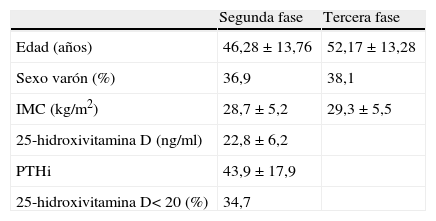El déficit de vitamina D y el síndrome metabólico son 2 entidades muy frecuentes en población española. Se ha sugerido que los pacientes con síndrome metabólico pueden tener déficit de vitamina D con mayor frecuencia que los sujetos sin él, y que unos valores bajos de vitamina D pueden predisponer al desarrollo de síndrome metabólico. No obstante, los resultados de estudios prospectivos y de intervención han sido diversos, sin que se haya aclarado por el momento si existe esta relación. El objetivo de este trabajo fue evaluar la relación entre los valores de 25-hidroxivitamina D y la prevalencia e incidencia del síndrome metabólico.
Pacientes y métodoSe realizó un estudio poblacional de cohortes. Al inicio del estudio (1996-1998), 1.226 pacientes fueron evaluados. Las visitas de seguimiento se llevaron a cabo en 2002-2004 y 2005-2007. Basalmente y durante el seguimiento, los participantes se sometieron a una entrevista y un examen clínico estandarizado con una prueba de tolerancia oral a la glucosa. En la segunda visita se midieron la 25-hidroxivitamina D y los valores de parathormona intacta.
ResultadosLa prevalencia de síndrome metabólico en la segunda y la tercera evaluación fue del 29,4 y del 42,5%, respectivamente. Los valores medios (DE) de 25-hidroxivitamina D fueron menores en los pacientes con síndrome metabólico, 21,7 (6,21) frente a 23,35 (6,29) ng/ml, p<0,001. La prevalencia de deficiencia de vitamina D (25-hidroxivitamina D<20ng/ml) en la segunda evaluación fue del 34,7%, con diferencias significativas entre los sujetos con y sin síndrome metabólico (34,6 frente a 26,5%, p<0,01). Los varones con deficiencia de vitamina D tuvieron con mayor frecuencia hipertensión y síndrome metabólico que aquellos con valores normales. Las mujeres con deficiencia de vitamina D tuvieron más frecuentemente hiperglucemia, hipertensión, aumento de la circunferencia de la cintura e hipertrigliceridemia. En el estudio prospectivo, los valores de 25-hidroxivitamina D<20ng/ml no se asociaron significativamente con un mayor riesgo de desarrollar el síndrome metabólico en los siguientes 5 años (odds ratio 0,99, intervalo de confianza del 95% 0,57-1,7, p<0,97) después de ajustar por sexo y edad.
ConclusionesLos pacientes con síndrome metabólico tienen con mayor frecuencia déficit de vitamina D, pero este no predice el riesgo de desarrollar síndrome metabólico.
Vitamin D deficiency and metabolic syndrome are 2 very common health problems in the Spanish population. It has been suggested that patients with metabolic syndrome may be vitamin D deficient more often than subjects without it and that low vitamin D levels may predispose to metabolic syndrome development. However, the results of prospective and intervention studies have been different and such relationship remains unclear. We assessed the relationship between 25-hydroxyvitamin D levels and the prevalence and incidence of metabolic syndrome.
Patients and methodsWe undertook a population-based cohort study in Spain. At baseline (1996-1998), 1,226 subjects were evaluated. Follow-up visits were performed in 2002-2004 and 2005-2007.At baseline and follow-up, participants underwent an interview and a standardized clinical examination with an oral glucose tolerance test in those subjects without known diabetes. At the second visit, 25-hydroxyvitamin D levels and intact parathyroid hormone levels were measured.
ResultsThe prevalence of metabolic syndrome at the second and third visit was 29.4 and 42.5%, respectively. Mean levels of 25-hydroxyvitamin D were lower in subjects with metabolic syndrome: 21.7 (6.21) vs 23.35 (6.29) ng/ml, P<.001.The prevalence of vitamin D deficiency (25-hydroxyvitamin D<20ng/ml) at the second evaluation was 34.7%, with significant differences between subjects with and without metabolic syndrome(34.6 vs 26.5%, P<.01). Men with vitamin D deficiency had more frequently hypertension and metabolic syndrome than men with normal levels. Women with vitamin D deficiency had more frequently hyperglycemia, hypertension, increased waist circumference and hypertriglyceridemia. In a prospective study, 25-hydroxyvitaminD values<20ng/ml were not significantly associated with an increased risk of developing metabolic syndrome in the next 5 years (odds ratio 0,99, 95% confidence interval 0.57-1.7, P=.97) after adjusting by sex and age.
ConclusionsVitamin D deficiency is associated with an increased prevalence but not with an increased incidence of metabolic syndrome.
Artículo
Comprando el artículo el PDF del mismo podrá ser descargado
Precio 19,34 €
Comprar ahora











